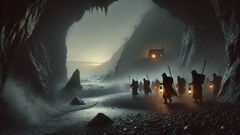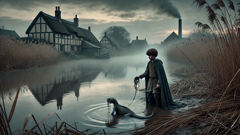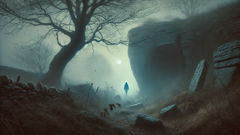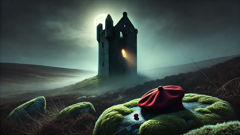Introduction
On a ragged seam of Scotland's coast where the land folds into harsh cliffs and the sea throws gorse-scented spray against black rock, the villagers of a small township told a story that could not sit quietly at the fire. They spoke in low voices of a cave sunk into the cliff face like a locked jaw, a hollow where men and women had turned away from the sun. The tale they told—half warning, half folklore—was of a family that withdrew from the world in an age of swords and superstition and, in its withdrawal, stripped itself of the boundaries that make civilization endure. Over twenty-five winters, they say, that family grew into a clan, and into something else: a closed economy of fear and appetite that fed not only on fish and the driftwood that washed ashore but on the flesh of travelers and the fragmentary remnants of nearby homesteads. In the telling, the details shift like shoreline fog—names, dates, numbers change with the teller—but the image remains constant: a mouth carved into the rock, a trail of missing people, a discovery so ghastly it altered the map of local memory. Historians will argue about provenance and motive; folklorists will trace ballads and broadsheets; poets and painters will linger on the shapes of shadows in that cave. This narrative is an attempt to weave those threads—archival fragments, oral fragments, and imaginative reconstruction—into a single tapestry that honors the loneliness and horror of an era when law was local and rumor could become history. It examines not just what was alleged to have occurred in that hidden hollow, but why such a story took hold of communities, how it was used, and why it refuses to dissipate under the clear light of modern scrutiny. As the tide erodes the cliff, so legends wear away and re-form; we will look closely at the stone and the shelter within, at the people who lived there according to tale, and at the witnesses who carried their memory out into the world.
Origins, Isolation, and the Shape of Fear
The story of Sawney Bean begins, in every telling, with a man and a decision. According to the oldest broadsides and the muttered recollections of coastal villagers, Alexander "Sawney" Bean was a quiet man who, like many in his time, walked the thin line between modest prosperity and destitution. In the fractured order of 15th-century Scottish life, where clan allegiance and local custom often meant more than royal edicts, a single theft or accusation might drive a person from community sustenance into cliffside exile. Whether Sawney fled a wrong he had committed, was driven by famine, or sought refuge from a blood-feud, the version of the tale that settled most firmly in local memory is the one that emphasizes choice: he walked to the shore, found a fissure in the rock, and made his home there.

His first years in the cave were, by all accounts, not spectacular; a man alone can survive on limpets and what the sea returns. In time he took a wife—one telling names her Margaret, another gives her no name at all—who accepted or was compelled to accept the cave as a lifetime's limit. There followed children and a life shaped by the constraints of stone, where daylight was measured not by hours but by the quality of light that reached the inner chamber. The clan expanded slowly, as most human groups do: births outpacing deaths, the constant intake of small conveniences stolen from unwary travelers, the odd livestock stolen from outlying crofts. The cave system described in the stories is complex: narrow entrances hidden by leaning rock, pockets where smoke could be vented, inner chambers rimmed with shells and bone—an architectural adaptation to a life lived half in darkness.
But isolation does more than change diet; it resets norms. The story insists that generations raised without neighbors develop customs adapted to scarcity and secrecy. Exchange with the outside was limited and furtive: a child's first memory might be the taste of meat cooked and bartered silently at night, the second the dim murmur of voices speaking names only when lamps were out and the tide was low. Over years, the clan's sense of right and wrong warped beneath the pressure of survival. Tales told in pub corners years later framed the transformation in stark terms: what begins as expediency deepens into appetite, what begins as theft becomes ritual, and the line that separates butcher from murderer blurs under the cover of practical necessity.
There is a particular cruelty to this imagined process, for it removes the convenience of a single monstrous origin and replaces it with something more chillingly human: a slow corrosion of moral rules. The clan in the cave is not simply bloodthirsty; it is resourceful, clever, and adaptive. They learn to watch the coast for wayfarers' carts, to time their movements with storms that hide footprints, to leave traps where fog obscures the trail. In the told history, this is where the legend moves from mere survival to systematic predation. Lost travelers, fishermen who missed their crossings, itinerant peddlers—these vanishances gather like pebbles into a mound of suspicion. Villagers exchange rumors about missing kin, gates are bolted tighter, priests are asked to bind the community with prayer against a nameless horror.
Yet the story also shows how fear is cultivated. It is not only the clan's deeds that create dread; it is the stories told around hearths when nets are mended and the wind presses at the thatch. For centuries, in communities with fragile lines of supply and law, rumor did the work of governance. If the cave's occupants were thieves and worse, then the tale of Sawney Bean served as a reminder to stay within bounds, to watch the road and to travel in numbers. Broadsides printed later—often sensationalized—stoked the flames further, doubling numbers of victims and darkening descriptions of the clan's interior life until the cave had become a symbol as much as a place: a symbol of what happens when humanity is cut adrift from its social moorings.
Modern readers will wonder about evidence beyond hearsay. There are records—scattered, inconsistent—of inquests and proclamations in the border counties, and there are contemporary ballads that narrate the capture and punishment in lurid detail. Yet these sources were often produced far from the communities they described, and their authors had incentives: to sell papers, to warn travelers, to provide moral exempla. The historian's task is to parse these layers: to see how a rumor could be fed by lawlessness, by economic strain, and by the theatrical appetite of a reading public hungry for the macabre. Even so, the endurance of the Sawney Bean legend speaks to something deeper than sensationalism. It embodies the anxieties of a people who lived where the sea and land met in violence and where the thinness of law left entire populations vulnerable to disappearance. Whether every detail is true or not, the story retains the power to disturb, because it asks us to imagine what we would do if the web of neighborly obligation frayed and left us to choose between human norm and survival.
Discovery, Justice, and the Afterlife of a Tale
If the first part of the legend concerns the slow inward collapse of a family's ethics, the second part concerns exposure—how the hidden becomes known, how silence breaks under the insistence of life. The discovery, as recounted in broadsheets and parish notes, tends to arrive with drama. Some versions say that a local lord's hounds chased a strayed animal to the very mouth of the cave and refused to return; others claim a shepherd found a human limb on the tide-mark and followed a trail of blood into the rock. The most repeated account involves a missing fisherman whose wife's relentless inquiry, door-to-door, led to a haggard testimony: a neighbor saw a cart in the night and followed the tracks to a point where there were none thereafter. Whatever the initial clue, the tale crescendos in a communal act of rescue and retribution: an armed party, often described as a blend of local militia and outraged townsfolk, approaches the cave at first light to uncover horrors that confirm every suspicion.

The cave, when it is entered in the narrative, is described with the sort of sensational detail that sells print: walls lined with bones, crude racks, the remains of garments, and in some tellings, evidence of cannibal feasts prepared and preserved. These images, repeated and amplified, solidify the clan's transformation from outcast to monster. The capture follows, sometimes bloodless and sometimes violent, and the prisoners are marched to the nearest town for public judgement. Broadsheets of the era—crafted for a market that consumed outrage as news—describe swift justice: in some accounts the clan members are executed en masse, their bodies poured into barrels of tar and burned, or anatomized as a public spectacle intended to deter others. Local ballads turned the story into stanza and chorus, each iteration altering the cadence and the moral line. For readers today, the method of punishment often reads as performative cruelty, a notion consistent with a legal culture that used public execution as both deterrent and entertainment.
But the historical record is not neat. Court rolls, where they exist, are thin on corroboration, while pamphlets and chapbooks were content to inflate tolls and tallies. Some historians suggest the story's longevity has as much to do with its utility as its truth: it allowed local elites to channel anxiety into spectacle, to assert authority by defining an absolute outsider, and to bind communities around a clear, if horrifying, moral. Others suggest darker motives: urban sensationalism projected onto rural poverty; political rivals spreading tales to discredit border settlements; clergy harnessing outrage to concentrate parishioners under the watchful eye of the church. That ambiguity—between documented event and rhetorical utility—is where the legend continues to thrive as a subject of inquiry.
Beyond the immediate drama of capture and punishment, the Sawney Bean story settled into the cultural imagination because it answered a human need for cautionary narrative. In isolated communities, the tale served as practical advice wrapped in horror: do not travel alone; do not leave the road; do not trust the dark places where law does not reach. At the same time, the narrative offered a scapegoat for collective fears about scarcity and decline: rather than reckon with structural forces like famine, disease, or failing harvests, the community could locate evil in an external 'other'—a clan living under the cliff. Folklorists point out that such stories simplify the economy of blame, centering moral outrage on a visible villain instead of on diffuse social problems.
The story's afterlife is also instructive. In the centuries that followed, Sawney Bean became a figure of popular imagination in Britain and beyond. Illustrators rendered him monstrous; playwrights and novelists borrowed the outline of the tale to explore the breakdown of family bonds; the tourist industry in later centuries even turned the coastlines associated with the story into a macabre attraction. Each retelling modified the emphasis—punishment in one, mystery in another, social analysis in a third—reflecting the cultural anxieties of the reteller's time. In the modern age of scholarship, the legend encourages a kind of double vision: it is simultaneously a primary item of curiosity and a mirror that reflects contemporaneous preoccupations about class, violence, and the limits of empathy.
Crucially, the persistence of the Sawney Bean story raises ethical questions about how communities remember trauma. The accounts that survive are often those written by the literate and the powerful; they emphasize spectacle and moral closure rather than the slow, painful processes of social breakdown. Contemporary retellings must therefore approach the legend with a layered empathy—recognizing the human capacity for violence, acknowledging the terror that the story has inspired for generations, and admitting the ways in which the tale may have been exploited. The cave at the cliff's base, whether it housed a clan of cannibals or a circle of impoverished exiles, remains an emblem of the dark edge where community ends and the unknown begins. The act of telling about that edge binds listeners into a community once more, but it also risks simplifying complexity into myth.
And yet, perhaps the most enduring lesson is the one the tale quietly proposes: legends persist because they speak to something true in human experience, even if the literal events are contested. Whether Sawney Bean's cave was filled with monstrous acts or with the desperate improvisations of the dispossessed, the story demands that we look at how fear and secrecy shape behavior, how isolation can erode the scaffolding of morality, and how communities expel their anxieties in stories that both warn and enthrall.
Conclusion
The legend of Sawney Bean sits at the intersection of history and imagination, a tale that has been sharpened and reshaped by centuries of telling. It can be read as a literal account of a clan who abandoned the communal rules of their time and fell into acts of predation; as a moral parable used by communities to reinforce obedience and vigilance; or as an instrument of sensationalist publishing that fed a hungry market for the grotesque. Whatever its origin, the story endures because it speaks to anxieties that remain current: the fear of isolation, the unsettling idea that ordinary people can commit unspeakable acts when bonds dissolve, and the social impulse to create monsters as a way of containing communal dread. When modern scholars and storytellers revisit the tale, they find not only the contours of a horrific narrative, but also the fingerprints of those who told it for their own purposes—priests, printers, landlords, poets—all of whom refracted the tale through the prisms of their times. In the end, the cave is both a real seam in the cliff and a metaphorical space where the limits of human morality are tested. The legend draws listeners close to the hearth to hear the crackle of warning as much as the thrill of terror, and it remains lodged in the cultural landscape because it forces us to ask hard questions about survival, responsibility, and the way communities remember the sins they most fear. Remembering Sawney Bean is less an act of voyeurism than an exercise in historical empathy: to hold in mind a story that unsettles us and to attempt—carefully—to understand why it was told and retold until it became, unmistakably, legend.













